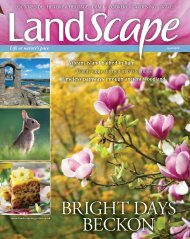Garden News Mini Mag
Garden News is the magazine for every gardener, bringing you everything you need to know in the garden each week. Each issue is packed full of practical, down-to-earth gardening tips, grow-your-own advice, ideas and inspiration, as well as all the latest news, new plants and products plus great money-saving offers and free gifts. See what we're all about in our sample mini mag!
Garden News is the magazine for every gardener, bringing you everything you need to know in the garden each week. Each issue is packed full of practical, down-to-earth gardening tips, grow-your-own advice, ideas and inspiration, as well as all the latest news, new plants and products plus great money-saving offers and free gifts. See what we're all about in our sample mini mag!
You also want an ePaper? Increase the reach of your titles
YUMPU automatically turns print PDFs into web optimized ePapers that Google loves.
The UK's No.1 gardening weekly!<br />
June 25, 2016 £1.99<br />
Britain's<br />
most trusted<br />
voice in<br />
gardening<br />
2 x FREE SEEDS<br />
£3.98!<br />
Worth<br />
7<br />
quick salads to<br />
harvest all summer<br />
2 x FREE SEEDS<br />
Worth<br />
£3.98!<br />
Carol<br />
Klein<br />
"Plant my<br />
midsummer<br />
dream –<br />
violets, thyme,<br />
& oxslips"<br />
Make colourful<br />
cistus the star of<br />
your border<br />
TIPS FOR PRUNING<br />
SPRING-FLOWERING<br />
SHRUBS<br />
"Try squash<br />
that tell you<br />
when they’re<br />
ready to eat!"<br />
says<br />
Rob Smith<br />
Get Weird your &<br />
cacti<br />
wonderful<br />
blooming<br />
blooming!<br />
cacti!<br />
Summer<br />
beauties!<br />
Grow your best-ever roses<br />
Easy-care giant clematis<br />
Colourful alpine stunners<br />
DRAMATIC DAHLIAS!<br />
The secret to guaranteed success
Easy summer salads<br />
P.20<br />
Roses are<br />
rewarding me<br />
for my work<br />
I have a beautifully-scented old<br />
climbing rose (‘Maigold’) that arches<br />
around the kitchen window. Last<br />
winter I gave it a prune – a real short<br />
back and sides. While I was doing it,<br />
I decided a change of style was also in<br />
order. I took a new shoot and trained it<br />
not over, but under the window. When<br />
I’d finished I must admit it looked<br />
rather scalped. What had I done? Well<br />
fast-forwarding to now, having given it<br />
a good spring feed, I know it’s forgiven<br />
me, as I’ve been treated to masses of<br />
blooms both under as well as around<br />
the window. Each stem now has<br />
twice as many flowers. Now<br />
I’ve just got to get<br />
deadheading! For more<br />
on roses turn to page 14.<br />
<strong>Garden</strong> <strong>News</strong> Editor<br />
Britain’s most trusted<br />
voice in gardening<br />
P.42<br />
Sow giant<br />
pumpkins<br />
P.14<br />
Grow you best<br />
roses ever<br />
P.32<br />
Prune early<br />
flowering<br />
shrubs<br />
Our cover star:<br />
‘Gertrude Jekyll’ is an upright<br />
vigorous rose that flowers around now,<br />
in early summer. It has beautiful, pink<br />
double rosettes and an exceptional,<br />
heady, old rose fragrance. It’s very<br />
healthy, reliable and repeat flowers.<br />
SUBSCRIBE TODAY<br />
& you<br />
can<br />
save<br />
up to<br />
67%<br />
Go to p44 for full details!<br />
Look inside!<br />
About Now<br />
4 <strong>News</strong> from the gardening world<br />
5 Plant of the week: Cistus<br />
6 Know Your Enemy<br />
7 My life in Plants<br />
9 Very Important Plant P.5<br />
11 Wildlife & <strong>Garden</strong> Naturally<br />
12 Top 5... time-saving mulches<br />
Features<br />
14 Grow you best-ever roses<br />
20 Easy summer salads<br />
22 <strong>Garden</strong> of the week<br />
27 Easy-care summer clematis<br />
30 Carol Klein: Create a<br />
Shakespeare-inspired bower<br />
58 Homegrown: Summer stems<br />
What To Do This Week<br />
33 Sow summer peas now<br />
32 Prune early flowering shrubs<br />
36 Sow your free seeds<br />
39 Rob Smith sings the praises of<br />
‘Honey Boat’ squash<br />
41 Martin Fish on prurning<br />
grapevines<br />
42 Sow giant pumpkins<br />
43 Plant outdoor tomatoes<br />
43 Medwyn Williams is sowing<br />
lettuce and carrots<br />
45 Terry Walton has lots of salad<br />
crops and potatoes to enjoy<br />
The Experts<br />
47 How to have healthy and<br />
damage-free dahlias<br />
48 Keep alpines flowering<br />
49 Weird and wonderful cacti<br />
50 Tony Dickerson answers your<br />
questions<br />
You and Your <strong>Garden</strong>s<br />
52 Readers’ gardens<br />
54 Your letters and photos<br />
66 <strong>Garden</strong>ing genius<br />
Offers & Competitions<br />
57 Prize-winning crossword<br />
60 Save £7 on six hardy fuchsias<br />
61 Buy 24 perennial jumbo plugs<br />
for £14.99<br />
62 Free ranunculus and cyclamen<br />
bulbs for every reader<br />
June 25 2016 / <strong>Garden</strong> <strong>News</strong> 3
Plant<br />
OF THE<br />
WEEK<br />
Six to try for fabulous colour<br />
Shutterstock<br />
Cistus!<br />
Delicate-looking blooms will<br />
flower now on this tough shrub<br />
C. albidus<br />
Large, bright pink, jagged<br />
flowers with yellow<br />
stamens. Height and spread:<br />
1m (3ft 4in).<br />
Alamy<br />
‘Prostratus’<br />
Small, white saucer-shaped<br />
flowers, with yellow centres.<br />
Height: 45cm (18in), spread:<br />
90cm (3ft).<br />
Crocus<br />
Shutterstock<br />
June hails the start of a<br />
steady stream of beautiful<br />
papery cistus, or rock rose,<br />
flowers – if healthy these plants<br />
will tumble forth with a<br />
profusion of intricate blooms,<br />
each one lasting just a day. It’s<br />
fascinating to examine their<br />
poppy-like petals, crumpled up<br />
and extremely delicate looking.<br />
And yet the shrubs themselves<br />
are really rather tough,<br />
originating from dry, sunny<br />
Mediterranean areas, evergreen<br />
and hardy through most of the<br />
UK. It’s their drought tolerance<br />
that shows the extent of their<br />
robustness though, coping with<br />
dusty, dry conditions, harsh sun<br />
and salty, coastal gardens.<br />
Keep them happy<br />
Cistus tolerates poor soils and<br />
good soils, but isn’t keen on<br />
chalky soils. They need<br />
extremely well-drained compost<br />
and lots of sun. Try them in a<br />
rockery but be sure to plant it<br />
now, so it gets settled in before<br />
autumn. They need minimal<br />
pruning, just trimming off dead<br />
flowers and dead foliage.<br />
● www.crocus.co.uk,<br />
tel: 01344 578 111.<br />
● www.burncoose.co.uk,<br />
tel:01209 860316.<br />
In 1895, cistus at the Royal Botanic <strong>Garden</strong>s<br />
at Kew were wiped out by a frost – all except<br />
one, its extra hardy Cistus laurifolius.<br />
C. purpureus<br />
Dark pink flowers<br />
attractively splashed with<br />
maroon splodges. Height<br />
and spread: 1m (3ft 4in).<br />
‘Decumbens’<br />
Large, pure white flowers<br />
with deep maroon central<br />
splashes. Height and spread:<br />
1m (3ft 4in).<br />
Crocus<br />
Shutterstock<br />
‘Silver Pink’<br />
A free-flowering profusion<br />
of beautiful baby pink-white<br />
blooms. Height and spread:<br />
90cm (3ft).<br />
‘Sunset’<br />
An eye-catching vivid<br />
pink, just like a rose or<br />
peony. Height: 60cm (2ft),<br />
spread: 90cm (3ft).<br />
Crocus<br />
Burncoose Nurseries
AboutNOW<br />
Enter the<br />
garden of<br />
smiles<br />
Temple-like topiary, magical<br />
sculptures and a nod to Blighty<br />
With more than 30<br />
themed gardens,<br />
there’s a nod to<br />
every culture and<br />
animal kingdom<br />
If you’re visiting Thailand this<br />
summer, the NongNooch<br />
Tropical Botanical <strong>Garden</strong><br />
between Pattaya and Sattaheep<br />
is well worth a daytrip or two.<br />
First opened in the 1980s,<br />
NongNooch is host to weird<br />
and wonderful attractions and<br />
themed gardens, including a<br />
Bonsai <strong>Garden</strong>, Desert Rose<br />
<strong>Garden</strong>, European<br />
<strong>Garden</strong>, Orchid <strong>Garden</strong>,<br />
Floating <strong>Garden</strong>, animal<br />
sculptures and a real zoo.<br />
There’s a hotel and<br />
eateries on site so you<br />
can stay long enough to enjoy all<br />
there is to offer. You could even<br />
make your way around the site<br />
by bike or pedal boat hire – or if<br />
you’re not<br />
scared of heights, the 3km Sky<br />
Walk! Visit www.nong<br />
noochgardenpattaya.com<br />
Photos: Shutterstock<br />
Butterfly House opens<br />
Next week sees the opening of the<br />
National Botanic <strong>Garden</strong> of Wales’ brand<br />
new Butterfly House – Plas Pilipala.<br />
More than 20 butterfly species will arrive as<br />
pupae, including species from Central and<br />
South America, the West Indies, Caribbean,<br />
Tonga, Australia, and Papua New Guinea. It<br />
opens to the public on July 1 and will also<br />
highlight the scientific research the gardens<br />
are doing with bees, pollen, honey, hoverflies,<br />
moths and other pollinators.<br />
The move comes as part of a larger drive to<br />
make the gardens more appealing as a family<br />
attraction. This will include holding more than<br />
100 days of family activity events, such as den<br />
building and pond dipping, a £50,000 new play<br />
Some of the new butterflies<br />
Polymorphic<br />
longwing<br />
Blue<br />
morpho<br />
park, a water zorbing pool and a new straw<br />
bale maze.<br />
For further information visit www.<br />
botanicgarden.wales, tel 01558 667149.<br />
Tailed<br />
jay<br />
The Butterfly House at the<br />
National Botanic <strong>Garden</strong> of Wales<br />
Asian<br />
swallowtail<br />
National Botanic <strong>Garden</strong> of Walesw<br />
Shutterstock<br />
How to help<br />
hedgehogs<br />
Who doesn’t love seeing a<br />
hedgehog snuffling<br />
around in their garden?<br />
Yet, surprisingly, a survey by the<br />
RSPB has revealed 24 per cent of<br />
280,000 people asked have never<br />
seen one in their plot. Now the<br />
charity is urging people to make<br />
their outdoor spaces more wildlife<br />
friendly to encourage more visits.<br />
In particular, hedgehogs are<br />
attracted to wild patches, and places<br />
to shelter such as woodpiles or a<br />
specially-made hedgehog house.<br />
Also, make sure your garden has a<br />
small access space, such as a 15cm<br />
(6in) hole under your fence or gate.<br />
They’ll repay your hospitality by<br />
keeping your tender plants free<br />
from nibbling slugs and snails.
<strong>Garden</strong><br />
OF THE<br />
WEEK<br />
<strong>Garden</strong>er Roger Roberts<br />
Location Wharfedale,<br />
34 Broadway, Duffield, Belper,<br />
Derbyshire, DE56 4BU<br />
Size Third of an acre<br />
Soil Mildly acidic, loamy with<br />
clay areas<br />
Aspect South-west facing<br />
Been in garden 22 years<br />
Open for the NGS Saturday July<br />
30 (11am-4pm), Sunday July<br />
31(10.30am-5pm). Admission<br />
£3.00, children free.<br />
More info visit www.ngs.org.uk<br />
Labour<br />
of love<br />
A whole world of design and spirited planting has been transported<br />
to a rural garden set among the hills and fields of Derbyshire<br />
The atmospheric<br />
Italian garden is<br />
a place to relax<br />
and reflect<br />
Words Karen Murphy<br />
Photos Neil Hepworth<br />
Roger Roberts, an<br />
untrained but keen and<br />
conscientious gardener<br />
from Belper, was attracted by the<br />
blank garden canvas before him<br />
when he moved in to his new<br />
home 22 years ago.<br />
There was just a mossy lawn,<br />
a high hedge, no shape or<br />
structure and rectangular lawns,<br />
front and back. “All the better<br />
to sit back, take a look at what<br />
I had and decide what I was<br />
going to do with it – there was<br />
so much potential.”<br />
Roger did as much<br />
research as possible, pausing<br />
to consider the garden’s aspect,<br />
wind patterns, soil and also<br />
where he wanted paths, grass<br />
and structures.<br />
After a couple of years<br />
enjoying the process of mulling<br />
it over, he set to work. Working<br />
full time, he was often away from<br />
home, but managed one garden<br />
project a year over 15 years. It’s<br />
now finished and in just a third<br />
of an acre he has 12 distinct areas<br />
of the garden,<br />
each planted up in a different<br />
style or theme according to parts<br />
of the world or planting styles<br />
that he loves.<br />
Roger sees himself as a plant<br />
collector, and has more than 500<br />
species in his garden. Every plant<br />
he has is documented, as well as<br />
when and how to look after or<br />
propagate it through the year.<br />
“I’ve tried many systems, but
The Japanese garden,<br />
complete with mossy banks, a<br />
stream, tea house and classic<br />
red planting, with blood grass<br />
and photinia on the left<br />
have the perfect one now. It’s<br />
so much easier to garden – you<br />
need to know what you’re<br />
looking after!”<br />
Once the plants and<br />
positioning became clear, then<br />
came the inspiration and design.<br />
Roger’s favourite area, owing to<br />
his time travelling abroad, is his<br />
Italian garden. His time in Italy<br />
cemented his love for their<br />
gardens and countryside, and he<br />
was keen to bring a sense of that<br />
home to Derbyshire.<br />
“I love statuary,” he says, “and<br />
have some marble busts, a statue<br />
of the Roman goddess, Hebe and<br />
some dramatic stone columns<br />
and pillars – they look great.”<br />
A terracotta wall is matched by<br />
a 12m (40ft) terracotta pinkstemmed<br />
birch – Betula<br />
albosinensis septentrionalis<br />
– while a pencil conifer, juniper<br />
‘Skyrocket’, looms behind<br />
atmospherically. Chopping down<br />
Continues over the page<br />
Roger’s pond has<br />
quickly become a<br />
home for fish and frogs
<strong>Garden</strong><br />
OF THE<br />
WEEK<br />
heavy trees<br />
in this area<br />
meant there’s<br />
more sun now,<br />
perfect for an Italian<br />
garden full of Mediterranean<br />
herbs and 80 pink hybrid tea<br />
roses. A seating area by the<br />
terracotta wall is the perfect<br />
place to sit with a gin and tonic,<br />
in front of a large mural painted<br />
by the local schoolmaster. Roger<br />
laughs, “he only used three pots<br />
of paint, a blue spray and 15 years<br />
later it’s still there!”<br />
Another standout feature of<br />
the garden is the stunning<br />
Japanese area, the inspiration of<br />
which is purely from books,<br />
garden visits and research. “I’ve<br />
been to Italy a lot but never been<br />
to Japan,” says Roger. “I have<br />
joined the Japanese <strong>Garden</strong><br />
Society though.”<br />
One area of the garden was<br />
distinctly mossy, so he decided<br />
not to fight it and, with the help<br />
of his graphic designer son, has<br />
created a wonderful tea garden,<br />
complete with teahouse. “It’s<br />
difficult to create a mossy garden<br />
from scratch, so I just went with<br />
what I had,” he says. “The birds<br />
peck at it, meaning it needs<br />
manicuring regularly. One day a<br />
month, I’m on my knees,<br />
painstakingly combing through<br />
and keeping it all trimmed<br />
back.”<br />
The north-facing fernery in<br />
this area is a key element, with<br />
easy-care blechnums, osmunda,<br />
dryopteris, aspleniums and<br />
athyriums to give an exotic feel.<br />
The view from the teahouse was<br />
important to get right, in order<br />
to see the winding stream<br />
leading to a thriving pond. The<br />
pond is a marvel in itself, and is<br />
perhaps the lowest maintenance<br />
part of Roger’s garden. “I don’t<br />
have to do anything to it at all, I<br />
planted some yellow flags and<br />
other pond plants there, and<br />
they keep the water clear and<br />
A stylish oriental<br />
moongate, left, separates<br />
the Japanese garden from<br />
the rest. Right, exotic<br />
looking martagon lilies<br />
are easy to grow in the UK
Roger’s pick<br />
for structure<br />
dmitro2009 /Shutterstock<br />
Colour is key in Roger’s<br />
garden, with themed<br />
areas of monarda and<br />
lilies in bright reds and<br />
yellows<br />
fresh all the time,” he says. There<br />
are newts, frogs and dragonflies,<br />
but incredibly about six or seven<br />
fish have found their way in.<br />
Used to planting one each of<br />
everything, Roger has recently<br />
discovered the benefit of<br />
planting perennials, as what<br />
once was the Mediterranean<br />
garden is now a Piet Oudolfinspired<br />
naturalistic haven. This<br />
by no means large area is packed<br />
with teems of colour-coded lilies,<br />
monarda, eupatorium,<br />
heleniums, echinacea, asters,<br />
sanguisorba and dots of grasses<br />
between. A large Trachycarpus<br />
fortunei that never stops growing<br />
has huge yellow flowers in June.<br />
There are plenty of jobs for<br />
him to do now in the garden, but<br />
his next one is to unwrap the<br />
exotics for the summer, plus his<br />
beech hedging and conifers need<br />
pruning in a week or two.<br />
And has the garden turned out<br />
as he planned? “I do worry about<br />
maintenance,” he says. “Do I<br />
simplify the garden as I get older<br />
or leave it in all its glory? But it’s<br />
as perfect as it can be, and there’s<br />
no space left to add anything.”<br />
Tilia cordata ‘Greenspire’<br />
This compact, neat and tidy small-leaved<br />
lime is ideal for pleaching. Height: 12m (40ft),<br />
spread: 17m (58ft).<br />
Aesculus pavia ‘Atrosanguinea’<br />
Hailing from the horse chestnut family, it has<br />
red candles and bronze-green leaves. Height:<br />
5m (17ft), spread: 3m (10ft).<br />
Cercis canadensis<br />
Spectacular red-pink leaves glow through<br />
spring and summer, deepening to orange in<br />
autumn. Height: 10m (34ft), spread: 10m (34ft).<br />
Roger’s rules for success<br />
1Get planning - it’s everything<br />
and cataloguing is a<br />
fantastic idea. Organisation is<br />
the key to making things easy<br />
for yourself.<br />
2Learn to propagate as it’s<br />
beneficial to your garden,<br />
and to others if you give<br />
cuttings away as gifts - it’s so<br />
Shutterstock Shutterstock<br />
Alamy<br />
easy to do once you know how.<br />
3Decide what you want your<br />
garden for – mine is for me<br />
and my passion for plants. It’s<br />
very high maintenance! It<br />
reflects me and my interests<br />
and is an outlet for creativity.<br />
4Add height and<br />
imagination to your patch.<br />
Ilex crenata<br />
A bushy evergreen shrub, perfect for clipping<br />
into Japanese ‘cloud tree’ shapes. Height: 4m<br />
(13ft 6in), spread: 3m (10ft).<br />
Acer griseum<br />
This slow-growing acer has attractive peeling<br />
bark. A tree that’s beautiful all year. Height:<br />
10m (34ft), spread: 10m (34ft).<br />
Trachycarpus fortunei<br />
Exotic large green palm fronds and yellow<br />
flowers in June. Needs winter protection.<br />
Height: 20m (65ft), spread: 2.5m (8ft4in).<br />
I see many gardens that are<br />
all exactly the same and<br />
planted at one level – why not<br />
try something new and<br />
different? Climbers can work<br />
wonders, so go for an akebia or<br />
Tropaeolum speciosum<br />
growing up an up obelisk – it’ll<br />
look wonderful.<br />
Shutterstock Shutterstock
CAROL KLEIN<br />
This week<br />
AT GLEBE<br />
COTTAGE<br />
Shakespeare’s moving<br />
dramas and sonnets give<br />
us lots of information<br />
about his life and times,<br />
including the sorts of plants,<br />
both wild and cultivated that<br />
were of interest in that era.<br />
However, of all the references to<br />
flowers and plants in his work,<br />
perhaps the best known is<br />
Oberon, King of the fairies’<br />
speech in A Midsummer Night’s<br />
Dream, where he tells us:<br />
“I know a bank where the wild<br />
thyme blows,<br />
Where oxlips and the nodding<br />
violet grows,<br />
Quite over-canopied with<br />
luscious woodbine,<br />
With sweet musk-roses and<br />
with eglantine…”<br />
The delightful oxlip is a rarity<br />
nowadays, though thankfully a<br />
few specialist growers continue<br />
to produce plants and Hayley<br />
Wood in Cambridgeshire is<br />
one of its last wild outposts<br />
and a great place to see them. I<br />
filmed there for our Wild About<br />
The <strong>Garden</strong> series made for<br />
Channel 4, maybe 20 years ago.<br />
Primrosecoloured<br />
oxlips<br />
are a rarity in<br />
the wild<br />
A Midsummer Night’s<br />
Dream!<br />
Use roses, violets, oxlips and honeysuckle to create<br />
a bower inspired by Shakespeare’s seasonal play<br />
Oxlip flowers are slightly more<br />
fulsome than the narrow bells of<br />
cowslips but with the pale colour<br />
of primroses. It’s a pretty plant<br />
and easy to cultivate but, as<br />
with many primroses and<br />
polyanthus, it benefits from<br />
being divided every couple<br />
of years to keep healthy.<br />
Gertrude Jekyll<br />
recommended splitting<br />
polyanthus ‘when the<br />
flowers were on the<br />
wane’, which is about<br />
now. Roots should be<br />
trimmed to about 10cm<br />
(4in) so they don’t wrap<br />
back on themselves<br />
when replanted and also<br />
to encourage the<br />
formation of fine, fibrous,<br />
feeding roots.<br />
Perhaps Shakespeare was<br />
Shutterstock<br />
adopting a bit of poetic licence<br />
when he mentions thyme in the<br />
same breath as oxlips. Thyme<br />
prefers a sunny, well-drained<br />
position, where the redolent oils<br />
on its tiny leaves are released<br />
freely in the heat of the sun. On<br />
the other hand, ‘nodding violets’<br />
as an accompaniment to oxlips is<br />
an entirely plausible proposition.<br />
They both enjoy the same<br />
shady conditions and humusrich<br />
soil, as does the ‘luscious<br />
woodbine’, the name by which<br />
honeysuckle went. Honeysuckle<br />
is essentially a woodland plant,<br />
but, like so many shady climbers,<br />
it relishes having roots in shady<br />
soil but its head in the sunshine.<br />
The woodbine of which<br />
Shakespeare writes was almost<br />
certainly Lonicera periclymenum,<br />
our native honeysuckle, and still<br />
the most widely-grown and<br />
highly-valued climbing plant for<br />
evening perfume. It starts to<br />
pump out its delicious fragrance<br />
of honey and nutmeg in the<br />
evening. Its long corolla tubes<br />
are pollinated by moths.<br />
Shakespeare mentions roses<br />
frequently and although we<br />
might recognise some of them,<br />
there would have been few of the<br />
multifarious hybrid roses that<br />
grace our gardens today. Most of<br />
those he referred to would have<br />
been wild roses – eglantine is<br />
Rosa rubiginosa, the sweet briar<br />
rose whose foliage and stems<br />
have an apple scent. Its flowers<br />
are pink with slightly waved<br />
petals and its hips are decorative.<br />
The sweet musk-rose was<br />
almost certainly native Rosa<br />
arvensis, a strong climber with
‘Most of the<br />
roses Shakespeare<br />
refers to would have<br />
been wild ones’<br />
My gardening Diary<br />
Potted verbasums<br />
add drama<br />
Shutterstock<br />
Dark-leaved<br />
heucheras<br />
for my talk<br />
Shutterstock<br />
heads of creamy, highly scented<br />
flowers. It’s more likely<br />
Shakespeare would have seen<br />
R. arvensis. We all know our<br />
R. canina dog rose but it’s nice<br />
to be reminded we have more<br />
than one native hedgerow rose.<br />
Brilliant<br />
yellow<br />
tuffets are<br />
erupting<br />
<strong>Garden</strong> World Images<br />
Mr Bowles’s golden sedge is<br />
probably the most exciting<br />
plant in our garden now. Huge<br />
tuffets of slender leaves of the<br />
most brilliant yellow have<br />
erupted in several small beds<br />
in the brick garden. They were<br />
planted to give the impression<br />
of moving through these small<br />
beds and helping integrate<br />
them into one garden.<br />
Romantic roses<br />
are mentioned<br />
frequently in<br />
the Bard’s work<br />
If you wanted to create<br />
your own Midsummer Night’s<br />
Dream venue, then planting<br />
honeysuckle, roses, violets and,<br />
perhaps, a pretty oxslip or two<br />
should enable you to weave a<br />
magical scenario.<br />
What’s looking good now<br />
Glowing golden sedge<br />
A.E. Bowles loved finding<br />
and collecting strange and<br />
unusual variants of native<br />
plants. Whenever he found<br />
them, he’d dig them up and<br />
plant them in his ‘Lunatic<br />
Asylum’ – a special bed built to<br />
accommodate his quirky finds.<br />
We often find self-sown<br />
seedlings in spaces between<br />
paving stones and the path<br />
bricks; invariably they’re the<br />
same bright glowing yellow as<br />
their parents, they never seem<br />
to revert to type.<br />
Beside purple-leaved<br />
Clematis recta ‘Purpurea’<br />
and chunks of brilliant blue<br />
provided by Anchusa azurea<br />
‘Loddon Royalist’ they make<br />
a winning combination.<br />
Jonathan Buckley<br />
MONDAY Verbascums potted up from open-ground<br />
plants have reached gigantic proportions. We gave them<br />
plenty of root room and they’ve repaid us with a sterling<br />
performance – their spikes are nearly 1m (39in) high. To use<br />
the drama to full effect, they’re standing one to a<br />
terracotta pot across the length of the front terrace.<br />
TUESDAY Our new 126-compartment module trays are<br />
splendid. They’re designed for vegetables but are ideal for<br />
small perennial and biennial seedlings. Only problem is<br />
getting the plants out again once they’ve rooted. Neil’s<br />
working on an invention to extract them easily!<br />
WEDNESDAY While filming recently for a forthcoming<br />
‘Right Plant, Right Place’ piece for <strong>Garden</strong>ers’ World in a<br />
Herefordshire meadow, the soil was as heavy and wet as in<br />
our field yet it contained such a wealth of wild flowers.<br />
Beginning to believe we could grow such beauties, too.<br />
THURSDAY At the Birmingham NEC for <strong>Garden</strong>ers’ World<br />
Live. It promises to be a little different this year and the<br />
layout of the marquee has changed to make selling and<br />
buying plants easier. There are more gardens too, including<br />
a rose-swathed gothic ‘ruin’.<br />
FRIDAY Tearing around various stages and theatres<br />
within <strong>Garden</strong>ers’ World Live. Today’s talk is based on my<br />
book Making a <strong>Garden</strong>. One of the great advantages of<br />
being at such a show is that there are plenty of plants<br />
around and exhibitors seem very helpful and willing to<br />
lend their wares.<br />
SATURDAY Planning to talk about container planting<br />
while filling a roomy container with a dark eucomis as its<br />
centrepiece, surrounded by dark-leaved heucheras and<br />
dahlias with loads of brilliant yellow flowers to be picked<br />
up by cosmos ‘Zanthos’.<br />
SUNDAY One batch of our seedlings are<br />
looking decidedly unhappy, with different<br />
varieties that were potted into the same<br />
compost all suffering similar<br />
symptoms. I’m going to send it off to<br />
the RHS to get it analysed.<br />
Carol Klein
Easy summ<br />
Delicious to eat and foolproof to grow – here are<br />
our seven top choices for salad crops to sow now<br />
1<br />
RADISHES<br />
are the ultimate<br />
fast food crop.<br />
Their small, peppery,<br />
colourful roots are<br />
ready to harvest just<br />
three to four weeks<br />
after sowing. Given a<br />
good free-draining soil<br />
which retains moisture,<br />
they’ll cause you little<br />
trouble, but do tend<br />
to bolt quickly if they<br />
dry out or are left for<br />
too long once roots<br />
are ready to harvest.<br />
To give you a reliable<br />
supply, small quantities<br />
are best sown thinly<br />
in drills about 10cm<br />
(4in) apart every two<br />
weeks up until August.<br />
Radishes grow well in<br />
pots but keep them<br />
well watered to<br />
prevent bolting.<br />
TRY ‘French<br />
Breakfast’, ‘Cherry<br />
Belle’ and ‘Mirabeau’.<br />
Attractive, long<br />
radish ‘French<br />
Breakfast’<br />
Photos: Shutterstock unless stated<br />
Delicious,<br />
fresh sugar<br />
snaps pep<br />
up a salad<br />
3SUGAR SNAP<br />
PEAS are perfect for<br />
a quick summer crop in<br />
around eight weeks. They need<br />
to be picked early or they’ll<br />
develop into not-so-sweet<br />
plump pods. See if they’re ready<br />
by snapping one in half and<br />
listening for the distinctive<br />
‘snap’ sound. Try growing up a<br />
cane wigwam support, sowing<br />
seed 5cm (2in) deep. Tie in<br />
growing shoots regularly and<br />
protect plants from mice and<br />
slugs with netting and organic<br />
slug pellets. Horticultural fleece<br />
will protect during summer<br />
against pea moth.<br />
TRY pea ‘Sugar Snap’ for extra<br />
sweet pods.<br />
2<br />
BABY<br />
COURGETTES<br />
are sweet, glossy and often<br />
still have their flower bud<br />
attached. Courgettes can be ready<br />
to pick in just eight weeks, so sow<br />
outdoors now for a summer crop.<br />
These hungry plants like fertile<br />
soil in a sheltered spot and should<br />
be spaced about 90cm (3ft) apart.<br />
They thrive in growing bags or<br />
large containers, but need regular<br />
watering and feeding with a tomato<br />
fertiliser once fruits are forming. Cut<br />
courgettes when 10cm (4in) long to<br />
encourage more fruit.<br />
TRY ‘Defender’ or yellow ‘Parador’<br />
4<br />
BABY<br />
BEETS<br />
and their beautiful,<br />
red-veined leaves,<br />
make a brilliant addition<br />
to salads. These reliable<br />
performers are tolerant<br />
of most garden soils, but<br />
need a deep pot for roots<br />
to swell quickly. Sow your<br />
seeds thinly in short rows<br />
15cm (6in) apart every three<br />
weeks from now to the end<br />
of July for a continuous<br />
harvest. Small baby beets<br />
are ready for picking after<br />
seven weeks and should<br />
be about the size of a table<br />
tennis ball after 9-10 weeks.<br />
Bolt-resistant varieties<br />
‘Boltardy’ and ‘Pablo’ are<br />
trusted choices.<br />
TRY yellow ‘Burpee’s<br />
Golden’, or striped ‘Chioggia<br />
Pink’ as summer alternatives.<br />
Pick baby beets<br />
after seven weeks
er salads<br />
Super quick-grow spring<br />
onions are ready in just<br />
over a month<br />
5<br />
SPRING<br />
ONIONS<br />
are compact and simple to<br />
grow, making them ideal in<br />
containers and window boxes, but<br />
in the garden, you’ll need a soil that<br />
can be raked to a fine tilth to get<br />
consistent germination. They’re best<br />
sown in drills 10cm (4in) apart, right<br />
until the end of June, for harvesting<br />
throughout the summer. They first<br />
reach a usable size after about six<br />
weeks and it’s best to pull them<br />
quickly before the bulbs get too big.<br />
TRY ‘White Lisbon’, ‘Ramrod, or<br />
purple-tinged ‘Apache’.<br />
Sweet, crunch<br />
carrots can<br />
produce baby<br />
roots in under<br />
two months<br />
A mix of potted<br />
salad leaves makes<br />
for easy pickings<br />
6 CUT-AND-<br />
COME-AGAIN<br />
LEAVES are ready<br />
in four weeks. A whole variety<br />
of loose-leaf lettuces and other<br />
leaves, such as mizuna, oriental<br />
mustard, pak choi and rocket,<br />
can be sown individually or<br />
mixed for a combination of<br />
colours, flavours and textures.<br />
To harvest, cut young leaves<br />
about 2cm (1in) from soil level,<br />
leaving the central growing<br />
points intact to give two or<br />
three more harvests. Grow in<br />
well-watered pots, window<br />
boxes, or decorative rows in the<br />
garden. Sow every two to three<br />
weeks outdoors until August.<br />
TRY lettuces ‘Green Salad Bowl’<br />
and ‘Catalogna’, rocket ‘Apollo’,<br />
or one of the seed mixes available.<br />
7<br />
BABY<br />
CARROTS have<br />
such a sugary crunch<br />
they’ll be lucky to make it<br />
as far as your salad bowl!<br />
Early, rather than maincrop,<br />
varieties are particularly fast<br />
growing and should produce<br />
baby roots in seven weeks.<br />
Seeds are best sown about<br />
1cm (½in) apart, in shallow<br />
drills 15cm (6in) wide, in<br />
fertile, well-drained soil.<br />
You can do this until the end<br />
of this month. Carrots also<br />
flourish in deep pots, where<br />
their feathery foliage looks<br />
attractive. Protect crops from<br />
carrot fly by growing under<br />
horticultural fleece.<br />
TRY fast-maturing ‘Ideal’<br />
for a rich taste.
What to do this week<br />
IN YOUR FLOWER GARDEN<br />
Prune early<br />
flowering<br />
shrubs<br />
Do it now so they have time<br />
to mature flowering wood<br />
It’s time to prune deciduous spring flowering<br />
shrubs such as forsythia, lilac and fothergilla.<br />
Wait until the last of the flowers have faded<br />
then dig out your loppers. Pruning straight after<br />
flowering means the shrub will have the summer<br />
to mature plenty of flowering wood for next spring.<br />
If you only have five minutes, just trim the stems<br />
back to remove old blooms. But if you want to<br />
maximise flowers, the best approach is to remove<br />
whole stems down to the ground after flowering.<br />
This will stop the structure becoming<br />
overcrowded, prevent stems rubbing together and<br />
encourage new stems to grow from the base. Aim<br />
to remove about one in five stems, distributed<br />
evenly through the shrub. Also remove any that are<br />
rubbing together or damaged.<br />
After pruning, sprinkle a handful of slow-release<br />
fertiliser around the base to give it a boost.<br />
If your shrub has been clipped and is too dense<br />
to start pruning in this way, you can<br />
opt to ‘renovate’ it by cutting it<br />
right down to the ground in<br />
winter. You’ll lose the<br />
flowers for one season<br />
but be rewarded by a<br />
more graceful shape<br />
the following year.<br />
<strong>Garden</strong> <strong>News</strong><br />
RECOMMENDS<br />
3 to cut back now<br />
Bauer<br />
Bauer<br />
Bauer<br />
Weigela<br />
Stems are smothered in pink or white blooms<br />
through late spring. To maximise them, prune<br />
the oldest stems to the ground now. Height:<br />
2.5m (8ft 4in).<br />
Viburnum bodnantense<br />
Flowering in winter and very early, this shrub<br />
will be in leaf by now. This is the latest you can<br />
prune to preserve next year’s flowers. Height:<br />
2.5m (8ft 4in).<br />
Halesia carolina<br />
This large shrub has pendant clusters of<br />
dainty white flowers. It likes a sheltered spot<br />
in neutral to acid soil. Tough winged fruit<br />
remain on tree in autumn. Height: 8m (26ft).
Summer<br />
prune now<br />
Trim your grapevines<br />
back to energise them!<br />
Greenhouse grapes have the advantage<br />
of a much longer growing season<br />
than vines planted outside, which<br />
hopefully results in a larger crop at the end<br />
of the season. Although vines are totally<br />
hardy, they need sunshine and warmth<br />
through the summer to make sure the<br />
grapes develop properly and ripen. A<br />
greenhouse or polytunnel helps to<br />
provide these growing conditions.<br />
Most vines can be vigorous and, if they’re<br />
not pruned regularly, would simply fill your<br />
greenhouse with a mass of long stems and<br />
foliage. In winter, all the previous season’s<br />
growth is cut back, and then at this time of<br />
year we need to carry out summer pruning.<br />
My vine is trained as a single rod (main<br />
stem) tied to a wire running along the ridge<br />
of the greenhouse. It’s currently in full<br />
growth and forming grapes. Pruning is fairly<br />
simple and basically consists of trimming<br />
back all the long shoots to a couple of leaves<br />
past the small bunches of grapes.<br />
If two bunches have developed on one<br />
stem, I usually cut the weaker one off to limit<br />
it to just a single bunch per stem. This way<br />
Jobs<br />
to do now<br />
MARTIN FISH<br />
The undercover<br />
GARDENER<br />
Former head gardener, TV and radio broadcaster and RHS judge<br />
you get slightly fewer bunches, but they’re<br />
better quality. If you want, you can also thin<br />
the grapes in each bunch, but this is very<br />
time consuming. I only remove a few<br />
bunches if I think the vine’s carrying too<br />
many to support.<br />
Once all the long growths have been<br />
shortened, the vine’s energy is diverted into<br />
grape growth, although new shoots will also<br />
develop from where you cut back to and<br />
these will need trimming back right<br />
through summer.<br />
A little water while the fruits are swelling<br />
and a high-potash feed will keep everything<br />
healthy. Then it’s a case of waiting for the<br />
grapes to ripen later in the summer.<br />
Sponsored by<br />
Healthy new<br />
bunches of<br />
grapes forming<br />
Tel: 01531 633659<br />
www.haygrove.co.uk<br />
Photos: Martin Fish<br />
Clear potatoes and replant<br />
with more vegetables<br />
We’ve been lifting potatoes in the polytunnel<br />
for a couple of weeks, despite the cold spring<br />
weather. Once they’re cleared, I’ll replant<br />
with some more veg.<br />
Prick out sweet williams<br />
and grow them on<br />
I’m growing sweet williams from seed for<br />
some early cut flowers next year. Seedlings<br />
are now ready to prick out and grow on before<br />
being planted in large pots in the polytunnel.<br />
Deadhead pelargoniums<br />
Pelargoniums and geraniums<br />
are flowering well in the<br />
greenhouse. Deadhead them<br />
regularly to keep the<br />
show going.<br />
Next week: Streptocarpus<br />
care and propagation
<strong>Garden</strong>ing with the<br />
EXPERTS<br />
The world’s finest share their tips for success<br />
Strong, well-fed<br />
plants will produce<br />
lots of flowers<br />
Dave Gillam<br />
A grower for 25 years, in 2012<br />
Dave won National Individual<br />
Champion awards at each of<br />
the English (Shepton Mallet),<br />
Welsh and Scottish National<br />
Dahlia Society competitions,<br />
the first time this has ever been accomplished.<br />
He’s very busy on YouTube, where you’ll find<br />
dozens of videos on how to grow dahlias.<br />
From June to August, dahlias should<br />
be happily growing in our beds<br />
and borders. However, as with any<br />
leafy plants, the moment they go in the<br />
ground you might just as well ring the<br />
dinner bell for all the local slugs, snails<br />
and aphids. Then, as the buds come<br />
along, earwigs join the party, too!<br />
The dwindling range of chemicals<br />
and controls makes things harder for<br />
us all, but fortunately, plant foods seem<br />
to be on the increase, and encouraging<br />
our dahlias to grow strongly helps<br />
keep them ahead of the pests.<br />
Hungry feeders<br />
Dahlias are naturally hungry plants,<br />
so providing regular feed helps them<br />
on their way. There are three basic<br />
food types that should be applied at<br />
different stages to fuel plant growth.<br />
I feed with high nitrogen (N) in June,<br />
which promotes strong plant and leaf<br />
growth, to build a strong base. This is<br />
commonly found in soluble lawn foods.<br />
July is the time to use a balanced feed<br />
of nitrogen (N) and potassium (K) in<br />
almost equal parts. This strengthens<br />
dahlias and starts hardening the plant<br />
ready to flower. General soluble foods such<br />
as Miracle-Gro or Gro-Sure are ideal.<br />
To aid flowering by stiffening the<br />
stems, apply a high-potash feed in<br />
Potash improves<br />
flower size<br />
Photos: David Gillam<br />
Add petroleum jelly to<br />
stems to stop earwigs<br />
in their tracks<br />
How to have healthy and<br />
damage-free dahlias<br />
Now’s the time to feed to keep plants strong<br />
August. The Potash (K) ripens growth<br />
and stems and improves flower size, as<br />
well as making the plant more weather<br />
tolerant. Suitable products include<br />
tomato feeds and most garden centres<br />
stock a box of sulphate of potash.<br />
Phosphate (P) is found in nearly all<br />
foods. It helps root growth and is only<br />
needed in small quantities. An initial base<br />
dressing of bone meal or blood, fish and<br />
bone is normally enough without the need<br />
to add more. Phosphate can remain in<br />
the soil for a long time so overapplication<br />
isn’t a good idea.<br />
If you’re just growing<br />
dahlias for flowering<br />
in the garden, a couple<br />
of balanced feeds and a<br />
couple of potash feeds of<br />
2.5-5 litres per plant will<br />
make a lot of difference.<br />
For show purposes, to get<br />
the full potential from your<br />
plants use the different<br />
products as described<br />
above every 10–14 days.<br />
For weaker-stemmed<br />
varieties, apply a dressing of<br />
sulphate of potash in mid-July<br />
Tackle pests early for<br />
pristine flowers<br />
and water in. It takes a while before the plant<br />
can take it in, so it needs doing in advance.<br />
Pest control<br />
I find off-the-shelf chemicals for pests work<br />
well enough, but for more stubborn pests I<br />
increase the recommended dose. To avoid<br />
pests and diseases, regularly check your<br />
plants and start any treatment at the first<br />
sign, rather than waiting for an outbreak.<br />
Spend enough time with your plants and<br />
you’ll recognise if there’s a problem.<br />
I use a light application of slug pellets<br />
prior to planting and then use them lightly<br />
after that. Don’t overuse them – only 10-15<br />
pellets per square metre is required, and they<br />
contain an attractant so if you over-apply<br />
them, you’ll simply encourage every slug<br />
around to your plants. I use organic-based,<br />
wildlife-friendly pellets from Growing<br />
Success because they drive the slugs<br />
underground to die, which means they’re<br />
less likely to be picked up by feeding birds.<br />
Earwigs don’t become a problem until later<br />
in the season. They’re nocturnal so they hide in<br />
the day and feed at night. A smear of petroleum<br />
jelly applied a few inches below the bud helps<br />
prevent any strays from feasting on the buds of<br />
large flowers or those needing extra protection.
Readers’<br />
gardens<br />
now!<br />
Over the<br />
FENCE<br />
Wallflowers<br />
and alliums<br />
make a striking<br />
contrast<br />
Echinopsis<br />
‘Bourne<br />
Sparkle’<br />
It’s busy on<br />
the plot!<br />
Derek<br />
Brooks<br />
Prize-winning<br />
veg from the<br />
allotment and<br />
a smaller garden<br />
in greater Manchester with<br />
impressive summer bedding.<br />
Photos: Richard Torr<br />
Bedding plan’s a triumph<br />
Richard<br />
Torr<br />
Trent Valley<br />
garden with<br />
a cottagestyle<br />
feel and<br />
an extensive greenhouse<br />
collection of cacti and<br />
succulents.<br />
Mixed hostas<br />
add interest<br />
for an NGS day<br />
The garden’s full of bloom,<br />
especially from shrubs<br />
including the magnificent<br />
white-flowered Viburnum<br />
plicatum ‘Mariesii’, a narrowleaved<br />
form of Choisya ternata<br />
(Mexican orange blossom) and a<br />
variegated weigela.<br />
In preparation for our two<br />
National <strong>Garden</strong>s Scheme open<br />
days recently, I displayed several<br />
hostas in pots at the front of<br />
the house. Although in full<br />
sun, with plenty of water the<br />
plants are thriving and have<br />
unfurled fresh, bright foliage.<br />
Bearded iris are in bloom,<br />
including a particularly nice<br />
dwarf blue variety with Iris<br />
sibirica starting to show plenty<br />
of flowers for the follow-on<br />
display. ‘Handel’ and ‘Albertine’<br />
roses are the first to show and<br />
Geranium palmatum is<br />
producing an eye-catching<br />
mass of pink.<br />
A bed of Allium hollandicum<br />
Rose ‘Handel’ is<br />
first to bloom<br />
‘Purple Sensation’ underplanted<br />
with orange/yellow Siberian<br />
wallflowers was a triumph, with<br />
the wallflowers continuing to<br />
bloom as the alliums fade.<br />
Tomato seedlings planted out<br />
in the greenhouse border are<br />
growing strongly. Flower buds<br />
are appearing, so I’ll feed them<br />
soon with a high-potash<br />
fertiliser. I’m growing heavycropping<br />
cherry tomato ‘Sweet<br />
Million’, old favourite ‘Ailsa Craig’<br />
and beefsteak ‘Super Marmande’<br />
with French marigolds planted<br />
in between to deter white fly.<br />
After a few weeks of growing<br />
on in the greenhouse, the<br />
planted wall baskets of multiflowered<br />
begonias and pink<br />
trailing geraniums look fantastic<br />
on the house walls.<br />
Cacti and succulents continue<br />
to flower well, especially<br />
echinopsis ‘Bourne Sparkle’,<br />
with 15 iridescent red/pink<br />
flowers out in one day.<br />
Photos: Richard Torr<br />
Weeds are springing up<br />
persistently and<br />
before I plant<br />
anything in the allotment, I’ve<br />
got to weed the beds again! At<br />
least the weather’s been dry<br />
enough to plant out celery, ‘Show<br />
Perfection’ peas, spray<br />
chrysanths, dahlias and tender<br />
veg, including runner beans,<br />
Lawn looks<br />
healthy after<br />
a spruce-up<br />
Linda<br />
Coy<br />
Spacious cottage<br />
style garden<br />
near York filled<br />
with perennials<br />
around shrubs and trees.
Like me? Buy me!<br />
On sale in all good retailers<br />
or get your exclusive <strong>Mini</strong><strong>Mag</strong> subscription by clicking here

















